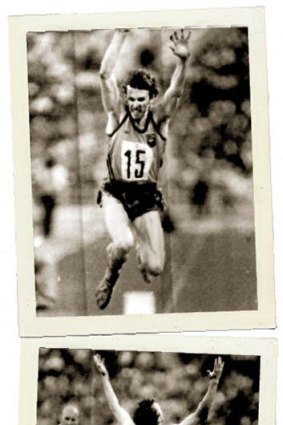By Tim Lane
Today is the last day of the 2013 world track and field championships. Not long before midnight Melbourne time on Sunday, as the field assembles for the men's triple jump final, Ian Campbell could be forgiven for cursing in his sleep amid yet another dream of what might have been.
It was 33 years ago at the stadium now known as Luzhniki - the last time Moscow hosted a global athletics championship - that Campbell was done over. He was Australia's outstanding triple jumper, ranked with the best in the world, and it is possible that what was taken from his grasp was gold.

Agony to ecstasy: Ian Campbell's joy turns to dismay after his jump was ruled a foul.
At the time of the 1980 Olympic Games, the main venue was called the Lenin Stadium.
Russia was part of the Soviet Union, the hammer and sickle remained an emblem to strike fear into the Western world, and, right down to the manner of officiating at sporting events, this was another era.
Cold War hostility was such that the US led a Western boycott of the Soviet Union's first Olympics - in protest at an invasion of Afghanistan! But despite the urgings of Australian prime minister Malcolm Fraser, the Australian Olympic Federation (as it was then known) held its nerve. A vote of six to five sent an Australian team to Moscow.
Once the events started, it was hard - from the other side of the globe - to discern fact from fiction. It was claimed, for example, that during the javelin throw the huge gates to the stadium were opened and closed at such times as to create drafts favouring Soviet athletes and hindering their opponents. It was a wonderful tale of Soviet conspiracy, but if - in imagining how it would work - you visualised the MCG, you weren't so sure it would.
Then there was the other gate: triple jump-gate. Campbell was a chance. At the previous year's World Cup, he had taken bronze. In 1980, he was in career-best form and in the Olympic qualifying round was the only athlete to better 17 metres. He and Brazil's world record holder, Joao Carlos de Oliveira, appeared the men to beat.
While the Soviets were not without hope, the legendary Georgian, Viktor Saneyev - seeking to win a fourth-straight Olympic title - was then 34. Estonian Jaak Uudmae was a rough chance. Non-Russian though they were, the pair would have close to 80,000 fans in support. Not to mention some cagey officials.
That the arena officials were Soviets is another part of the story. Campbell says it emerged later that the International Olympic Committee had allowed the International Amateur Athletics Federation's referees to be replaced by locals for all field events.
Campbell and de Oliveira each jumped six times in the final and nine of their collective 12 attempts were adjudged fouls. After Campbell's first jump was red flagged, he asked to see the plasticine strip that picks up markings beyond the take-off board. He was a right-foot launcher yet the indentation was at the left-hand end of the plasticine. The most contentious moment, though, was yet to come.
Campbell's recollection is that it was round three; others say it was the fourth jump. Whatever, it took him well beyond the Olympic record marker but was also ruled a foul. The Australian immediately protested, but in vain. It was explained to him that he had scraped his foot during the ''step'' motion. The pit was immediately raked.
Campbell insists ''scraping'' is rare.
''In my career I scraped a couple of times. I knew it, you know it, and, if you're wearing spikes, you're in trouble at that speed.''
The notion that an athlete could scrape and yet break an Olympic record was, he says, preposterous. Subsequently, the rule was scrapped.
De Oliveira, meanwhile, was also having problems. He produced one jump - ruled a foul - which Campbell says was ''absolutely enormous''. The Australian acknowledges ''there's every chance he jumped further than me''.
In the end, though, Uudmae won the event, Saneyev taking silver. De Oliveira took bronze for the second-straight Olympics, while Campbell's only clean jump of 16.72 metres gained him fifth place.
The fate of Brazil's long-time world record holder brings perspective to Campbell's view of his own cursed luck. In late 1991, de Oliveira was critically injured in a road accident and would eventually lose a leg. He died from causes related to alcohol abuse, aged just 45.
Campbell's subsequent physical problems pale by comparison. He was merely forced into retirement the year after Moscow by an ankle that was ''completely destroyed''. Today, he takes a philosophical view of the combination of the Games disappointment and the injury. ''I wouldn't have had a professional career if I'd won and stayed healthy.''
Through the years he has said little of his Olympic disappointment, but was moved to address it by the death of his father, Lindsay, four years ago. Campbell, 56, describes his parents as ''working-class stock'', from Watsonia, who sacrificed much for his career.
Years earlier, when Campbell worked for Nike and pole vault great Sergey Bubka was the company's brightest European star, the penny had dropped with the Ukrainian. ''Oh my god,'' he had exclaimed, ''you're the Ian Campbell from Moscow.'' Bubka's coach subsequently told Campbell, over dinner at Bubka's home in Donetsk, that ''the whole thing was a fix''.
In his book Higher Richer Sleazier, Australian journalist Roy Masters suggests the result was rigged as part of a deal involving the International Olympic Federation and shoe manufacturer Mizuno.
The Japanese company felt it had been betrayed at the opening ceremony when the Soviet athletes who lit the flame were wearing adidas shoes. A solution was arranged, Masters alleges, whereby Mizuno would be worn by Soviet athletes in an event they would win, and that event was the triple jump.